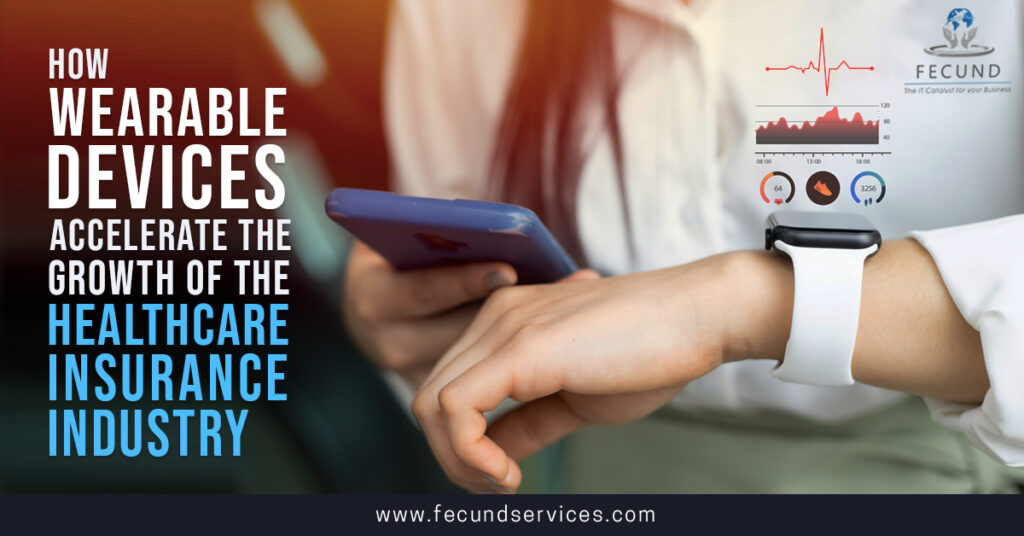
How wearable devices accelerate the growth of the healthcare insurance industry?
A large part of the human population has started using health monitoring watches, blood checkup kits, and health-tracking wearable devices. It shows the new generation of customers is more concerned about their health. The number of users of wearable devices is increasing day by day because of its benefits and personalized functions.
What are wearables?
Wearables are electronic technology or devices incorporated into products that can comfortably be worn on a body. These devices are easy to carry and easy to operate. They provide real-time data which shows the current state of the body of the user. Wearable devices use the technology known as motion sensors that take the snapshot of day-to-day activity and sync them with mobile devices or laptop computers.
Wearable technology collects the data of the user as this creates an opportunity for the health insurance industry. Let’s see how wearable devices improve the health insurance industry.
Benefits of wearable devices to the insurance industry:
Understand the customer health profile:
Health insurance companies analyze the health profile of the policy applicants, as it provides them a brief understanding of the customer’s health. Real-time data collected through the wearable device help an insurer to understand the health of the user. The data collected through the wearable represents the customer’s lifestyle and generated data shows how their body reacts to their lifestyle.
Real-time data:
Many research companies report that some people find wearable devices have motivated them to walk more regularly and achieve their health goals. Wearable devices help their users to make changes in their lifestyle by providing more control to their habits. The real-time metrics of the body influence a user to make healthy choices. Policyholders can self-monitor their health and track their progress. The more fit people are, they are less prone to health problems, and the less they feel a need for filing insurance claims. Wearable devices monitor healthy sleep, sleep patterns, blood pressure, blood oxygen level, calorie burn, fat count, heart rate, and stress level. There are many cases seen online that show how wearable devices have saved the life of its user.
Reward policyholders:
Wearable device companies are working towards generating accurate analysis and preventing metric fraud with secure technology. It will give the insurance company complete data of the person. The insurer can plan to provide rewards to their customers who take care of their health with the help of the data. These rewards can be of any form similar to a premium discount, compensation, or gifts. When a customer gets rewarded for maintaining good care of their health, it automatically encourages and motivates them to keep going.
For example, a person who maintains a healthy lifestyle will show good metrics on the wearable device’s dashboard. Insurance companies can provide rewards to them like premium discounts and others.
Identify the level of risk:
Wearable devices represent the health profile of the user. The health profile provides an idea about the risk an insurer will bear after insuring a person. It is a hypothesis that the person who takes care of health and maintains a good lifestyle comes into the less risky profile. The matrix shown by the wearable devices shows the customer’s body responses to some activity, habits, behavior. It became easy for the insurer to understand the customer better.
Identify opportunity:
Data collected through wearable devices represent customers’ lifestyles, which allows an insurance company to come up with more diversified and personalized policies. It then became easy to select and sell the insurance policy to the people who might need it.
Premium prices:
The more detail a health insurance provider gets about the customer’s health, the more it supports the underwriter with fair premium prices. The premium allows the customer to pay for how much they are insuring their risk.
Marketing and sales:
Marketing the policies is very difficult when there is no accurate information about the customer problems. Wearable devices collect the data of the customers, and it helps insurers to understand customer problems better. The set of people who face the same issues can become target customers, and insurers can provide them a perfect solution. It became easy for the marketing team to market the policies to the right customers and increase sales.
Policy modifications:
The information collect from the devices highlights some points which shows the opportunity to modify or make changes in the current policies, which eventually benefits the insurance companies to provide more customized services.??
Conclusion:
Health insurance companies can use the metrics collected by wearable devices as base data. An insurer can use this data to understand customer profiles, create new policies, market the product, understand the user’s needs and generate sales through the right marketing strategies.




Post a comment